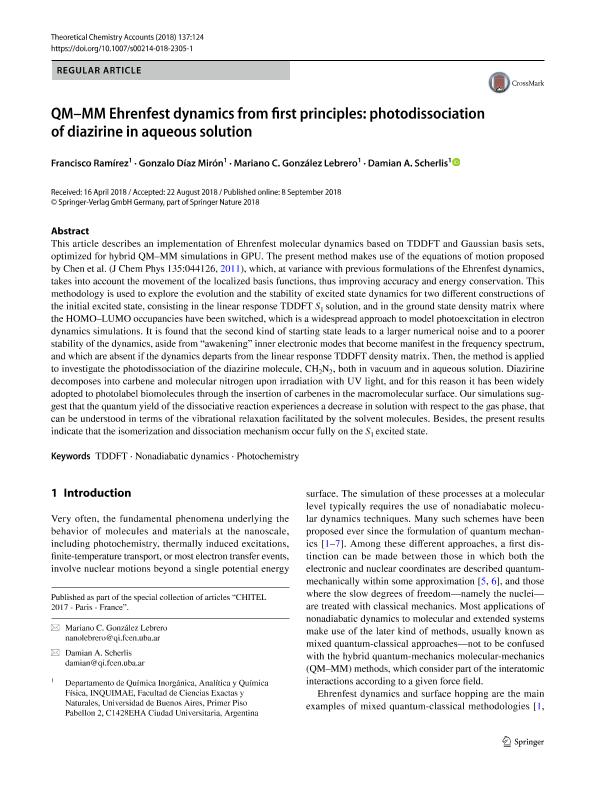Mostrar el registro sencillo del ítem
dc.contributor.author
Ramírez, Francisco Fernando

dc.contributor.author
Díaz Mirón, Gonzalo

dc.contributor.author
González Lebrero, Mariano Camilo

dc.contributor.author
Scherlis Perel, Damian Ariel

dc.date.available
2019-11-20T22:13:31Z
dc.date.issued
2018-09
dc.identifier.citation
Ramírez, Francisco Fernando; Díaz Mirón, Gonzalo; González Lebrero, Mariano Camilo; Scherlis Perel, Damian Ariel; QM–MM Ehrenfest dynamics from first principles: photodissociation of diazirine in aqueous solution; Springer; Theoretical Chemistry Accounts; 137; 9; 9-2018; 1-9
dc.identifier.issn
1432-881X
dc.identifier.uri
http://hdl.handle.net/11336/89335
dc.description.abstract
This article describes an implementation of Ehrenfest molecular dynamics based on TDDFT and Gaussian basis sets, optimized for hybrid QM–MM simulations in GPU. The present method makes use of the equations of motion proposed by Chen et al. (J Chem Phys 135:044126, 2011), which, at variance with previous formulations of the Ehrenfest dynamics, takes into account the movement of the localized basis functions, thus improving accuracy and energy conservation. This methodology is used to explore the evolution and the stability of excited state dynamics for two different constructions of the initial excited state, consisting in the linear response TDDFT S1 solution, and in the ground state density matrix where the HOMO–LUMO occupancies have been switched, which is a widespread approach to model photoexcitation in electron dynamics simulations. It is found that the second kind of starting state leads to a larger numerical noise and to a poorer stability of the dynamics, aside from “awakening” inner electronic modes that become manifest in the frequency spectrum, and which are absent if the dynamics departs from the linear response TDDFT density matrix. Then, the method is applied to investigate the photodissociation of the diazirine molecule, CH2N2, both in vacuum and in aqueous solution. Diazirine decomposes into carbene and molecular nitrogen upon irradiation with UV light, and for this reason it has been widely adopted to photolabel biomolecules through the insertion of carbenes in the macromolecular surface. Our simulations suggest that the quantum yield of the dissociative reaction experiences a decrease in solution with respect to the gas phase, that can be understood in terms of the vibrational relaxation facilitated by the solvent molecules. Besides, the present results indicate that the isomerization and dissociation mechanism occur fully on the S1 excited state.
dc.format
application/pdf
dc.language.iso
eng
dc.publisher
Springer

dc.rights
info:eu-repo/semantics/openAccess
dc.rights.uri
https://creativecommons.org/licenses/by-nc-sa/2.5/ar/
dc.subject
NONADIABATIC DYNAMICS
dc.subject
PHOTOCHEMISTRY
dc.subject
TDDFT
dc.subject.classification
Físico-Química, Ciencia de los Polímeros, Electroquímica

dc.subject.classification
Ciencias Químicas

dc.subject.classification
CIENCIAS NATURALES Y EXACTAS

dc.title
QM–MM Ehrenfest dynamics from first principles: photodissociation of diazirine in aqueous solution
dc.type
info:eu-repo/semantics/article
dc.type
info:ar-repo/semantics/artículo
dc.type
info:eu-repo/semantics/publishedVersion
dc.date.updated
2019-10-16T15:24:57Z
dc.journal.volume
137
dc.journal.number
9
dc.journal.pagination
1-9
dc.journal.pais
Alemania

dc.journal.ciudad
Berlin
dc.description.fil
Fil: Ramírez, Francisco Fernando. Consejo Nacional de Investigaciones Científicas y Técnicas. Oficina de Coordinación Administrativa Ciudad Universitaria. Instituto de Química, Física de los Materiales, Medioambiente y Energía. Universidad de Buenos Aires. Facultad de Ciencias Exactas y Naturales. Instituto de Química, Física de los Materiales, Medioambiente y Energía; Argentina
dc.description.fil
Fil: Díaz Mirón, Gonzalo. Consejo Nacional de Investigaciones Científicas y Técnicas. Oficina de Coordinación Administrativa Ciudad Universitaria. Instituto de Química, Física de los Materiales, Medioambiente y Energía. Universidad de Buenos Aires. Facultad de Ciencias Exactas y Naturales. Instituto de Química, Física de los Materiales, Medioambiente y Energía; Argentina
dc.description.fil
Fil: González Lebrero, Mariano Camilo. Consejo Nacional de Investigaciones Científicas y Técnicas. Oficina de Coordinación Administrativa Ciudad Universitaria. Instituto de Química, Física de los Materiales, Medioambiente y Energía. Universidad de Buenos Aires. Facultad de Ciencias Exactas y Naturales. Instituto de Química, Física de los Materiales, Medioambiente y Energía; Argentina
dc.description.fil
Fil: Scherlis Perel, Damian Ariel. Consejo Nacional de Investigaciones Científicas y Técnicas. Oficina de Coordinación Administrativa Ciudad Universitaria. Instituto de Química, Física de los Materiales, Medioambiente y Energía. Universidad de Buenos Aires. Facultad de Ciencias Exactas y Naturales. Instituto de Química, Física de los Materiales, Medioambiente y Energía; Argentina
dc.journal.title
Theoretical Chemistry Accounts

dc.relation.alternativeid
info:eu-repo/semantics/altIdentifier/url/https://link.springer.com/article/10.1007/s00214-018-2305-1
dc.relation.alternativeid
info:eu-repo/semantics/altIdentifier/doi/https://doi.org/10.1007/s00214-018-2305-1
Archivos asociados
